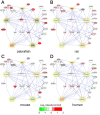Diet-induced obesity in zebrafish shares common pathophysiological pathways with mammalian obesity
- PMID: 20961460
- PMCID: PMC2972245
- DOI: 10.1186/1472-6793-10-21
Diet-induced obesity in zebrafish shares common pathophysiological pathways with mammalian obesity
Abstract
Background: Obesity is a multifactorial disorder influenced by genetic and environmental factors. Animal models of obesity are required to help us understand the signaling pathways underlying this condition. Zebrafish possess many structural and functional similarities with humans and have been used to model various human diseases, including a genetic model of obesity. The purpose of this study was to establish a zebrafish model of diet-induced obesity (DIO).
Results: Zebrafish were assigned into two dietary groups. One group of zebrafish was overfed with Artemia (60 mg dry weight/day/fish), a living prey consisting of a relatively high amount of fat. The other group of zebrafish was fed with Artemia sufficient to meet their energy requirements (5 mg dry weight/day/fish). Zebrafish were fed under these dietary protocols for 8 weeks. The zebrafish overfed with Artemia exhibited increased body mass index, which was calculated by dividing the body weight by the square of the body length, hypertriglyceridemia and hepatosteatosis, unlike the control zebrafish. Calorie restriction for 2 weeks was applied to zebrafish after the 8-week overfeeding period. The increased body weight and plasma triglyceride level were improved by calorie restriction. We also performed comparative transcriptome analysis of visceral adipose tissue from DIO zebrafish, DIO rats, DIO mice and obese humans. This analysis revealed that obese zebrafish and mammals share common pathophysiological pathways related to the coagulation cascade and lipid metabolism. Furthermore, several regulators were identified in zebrafish and mammals, including APOH, IL-6 and IL-1β in the coagulation cascade, and SREBF1, PPARα/γ, NR1H3 and LEP in lipid metabolism.
Conclusion: We established a zebrafish model of DIO that shared common pathophysiological pathways with mammalian obesity. The DIO zebrafish can be used to identify putative pharmacological targets and to test novel drugs for the treatment of human obesity.
Figures





References
-
- Speakman JR. Obesity: the integrated roles of environment and genetics. J Nutr. 2004;134(8 Suppl):2090S–2105S. - PubMed
Publication types
MeSH terms
Substances
LinkOut - more resources
Full Text Sources
Medical
Molecular Biology Databases
Miscellaneous

